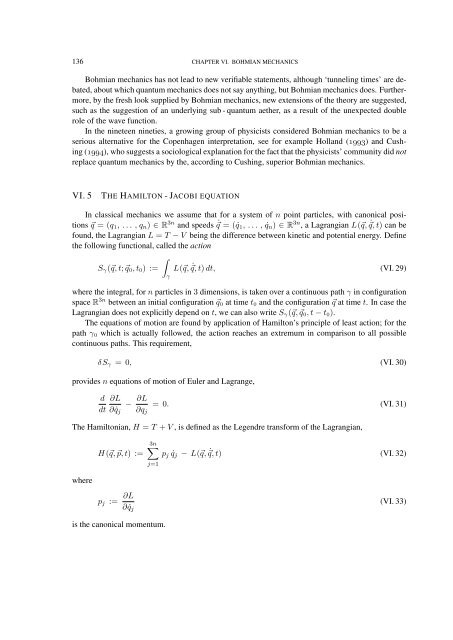FOUNDATIONS OF QUANTUM MECHANICS
FOUNDATIONS OF QUANTUM MECHANICS
FOUNDATIONS OF QUANTUM MECHANICS
Create successful ePaper yourself
Turn your PDF publications into a flip-book with our unique Google optimized e-Paper software.
136 CHAPTER VI. BOHMIAN <strong>MECHANICS</strong><br />
Bohmian mechanics has not lead to new verifiable statements, although ‘tunneling times’ are debated,<br />
about which quantum mechanics does not say anything, but Bohmian mechanics does. Furthermore,<br />
by the fresh look supplied by Bohmian mechanics, new extensions of the theory are suggested,<br />
such as the suggestion of an underlying sub - quantum aether, as a result of the unexpected double<br />
role of the wave function.<br />
In the nineteen nineties, a growing group of physicists considered Bohmian mechanics to be a<br />
serious alternative for the Copenhagen interpretation, see for example Holland (1993) and Cushing<br />
(1994), who suggests a sociological explanation for the fact that the physicists’ community did not<br />
replace quantum mechanics by the, according to Cushing, superior Bohmian mechanics.<br />
VI. 5<br />
THE HAMILTON - JACOBI EQUATION<br />
In classical mechanics we assume that for a system of n point particles, with canonical positions<br />
⃗q = (q 1 , . . . , q n ) ∈ R 3n and speeds ˙⃗q = ( ˙q 1 , . . . , ˙q n ) ∈ R 3n , a Lagrangian L(⃗q, ˙⃗q, t) can be<br />
found, the Lagrangian L = T − V being the difference between kinetic and potential energy. Define<br />
the following functional, called the action<br />
∫<br />
S γ (⃗q, t; ⃗q 0 , t 0 ) := L(⃗q, ˙⃗q, t) dt, (VI. 29)<br />
γ<br />
where the integral, for n particles in 3 dimensions, is taken over a continuous path γ in configuration<br />
space R 3n between an initial configuration ⃗q 0 at time t 0 and the configuration ⃗q at time t. In case the<br />
Lagrangian does not explicitly depend on t, we can also write S γ (⃗q, ⃗q 0 , t − t 0 ).<br />
The equations of motion are found by application of Hamilton’s principle of least action; for the<br />
path γ 0 which is actually followed, the action reaches an extremum in comparison to all possible<br />
continuous paths. This requirement,<br />
δS γ = 0, (VI. 30)<br />
provides n equations of motion of Euler and Lagrange,<br />
d<br />
dt<br />
∂L<br />
∂ ˙q j<br />
− ∂L<br />
∂q j<br />
= 0. (VI. 31)<br />
The Hamiltonian, H = T + V , is defined as the Legendre transform of the Lagrangian,<br />
H (⃗q, ⃗p, t) :=<br />
3n∑<br />
j=1<br />
p j ˙q j − L(⃗q, ˙⃗q, t) (VI. 32)<br />
where<br />
p j := ∂L<br />
∂ ˙q j<br />
(VI. 33)<br />
is the canonical momentum.
















